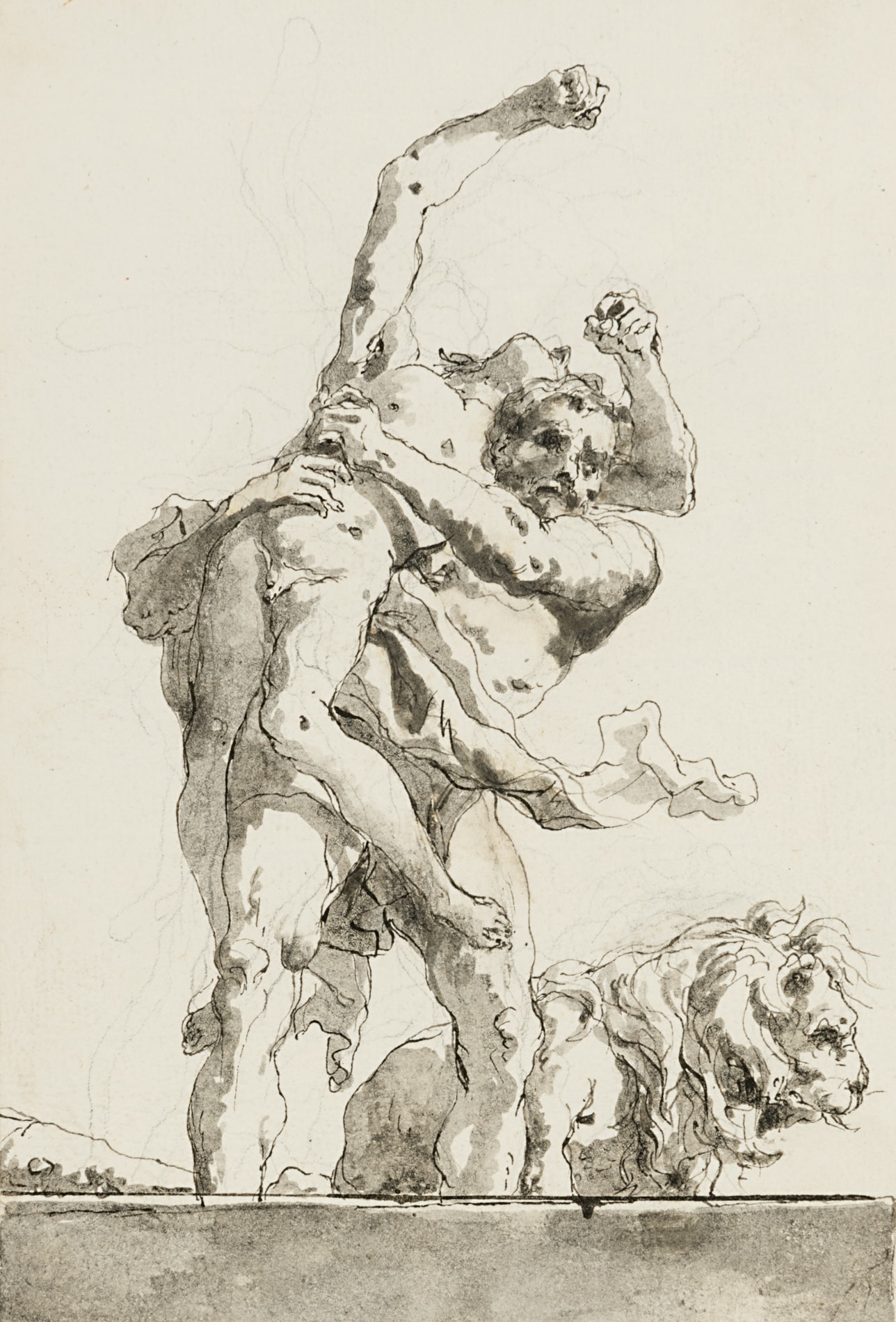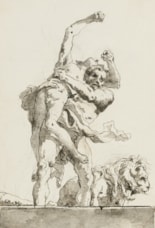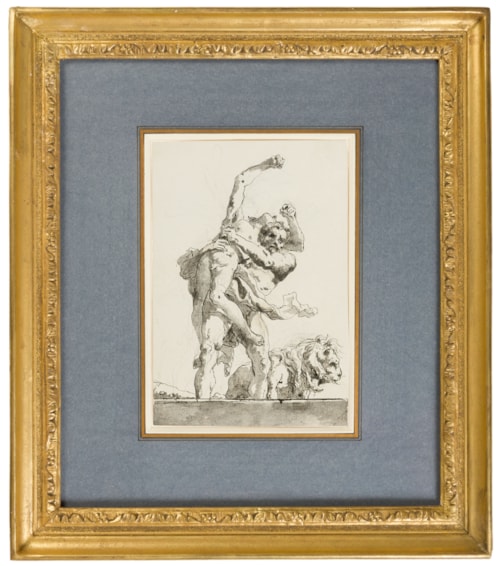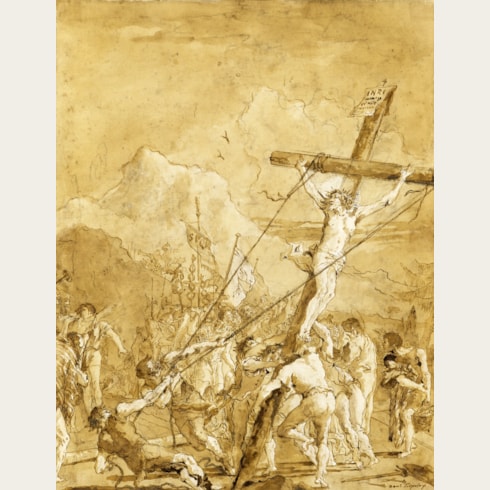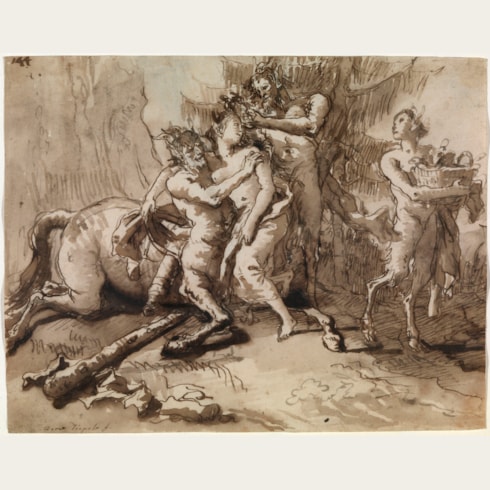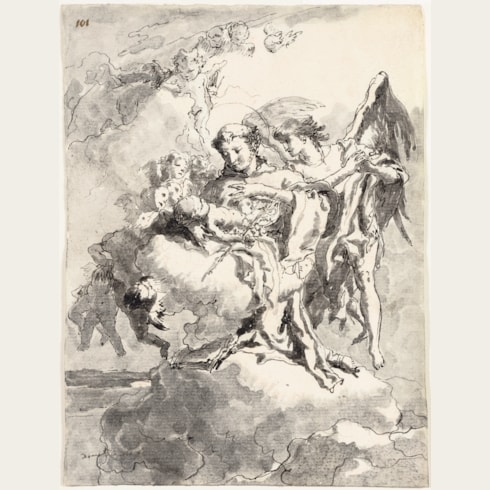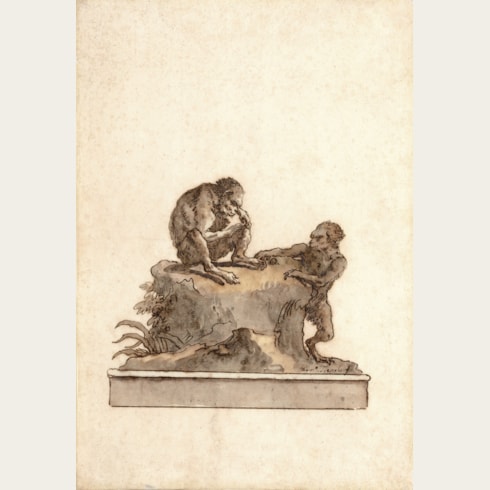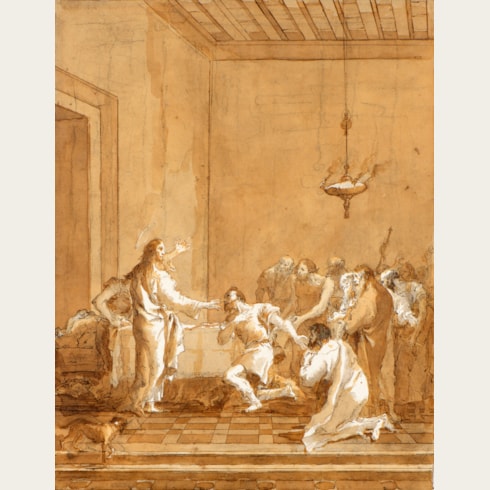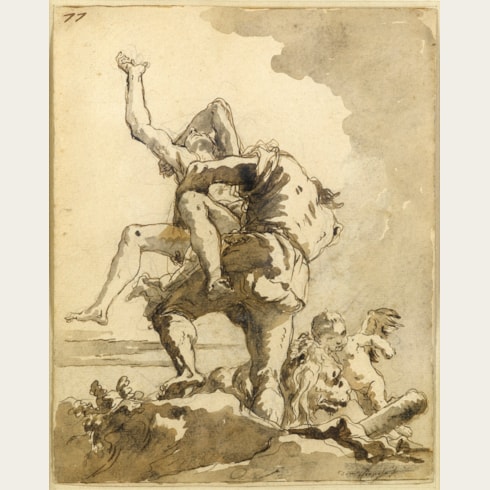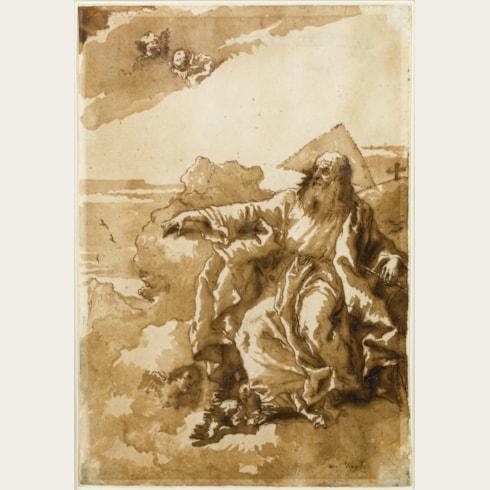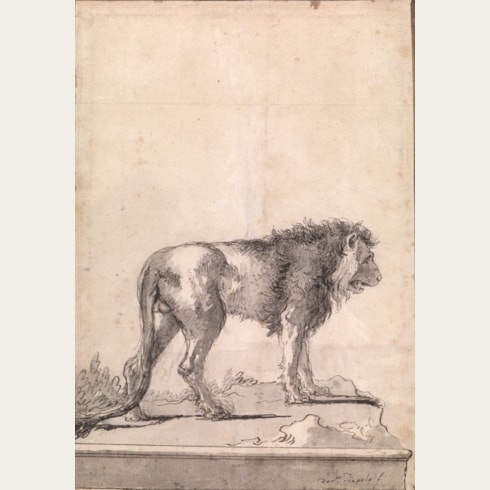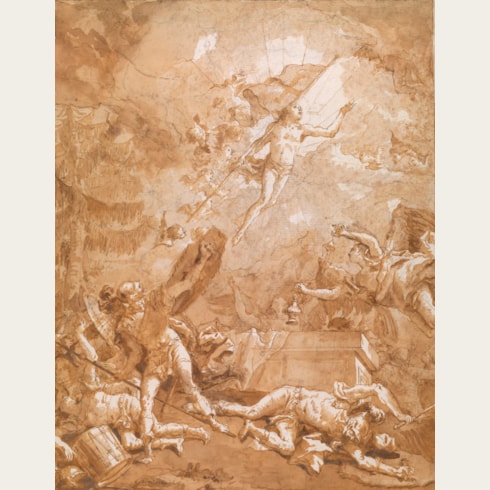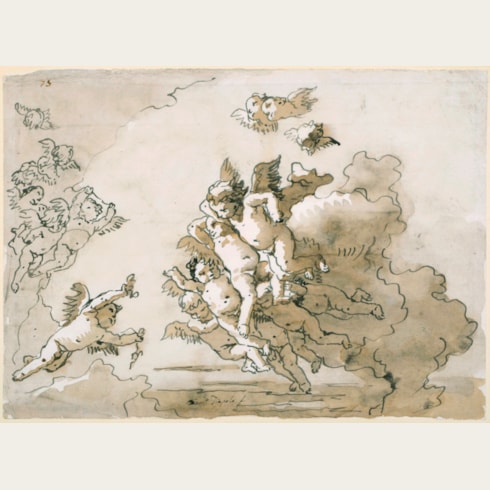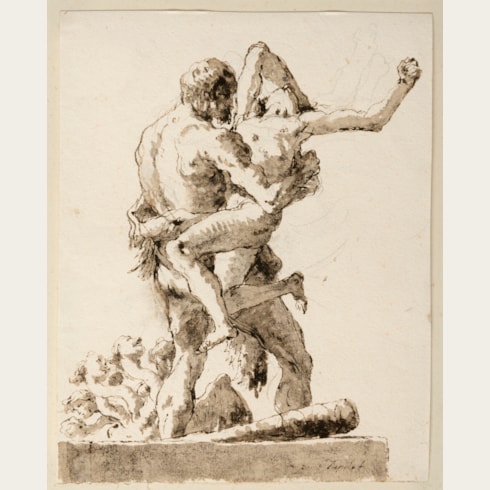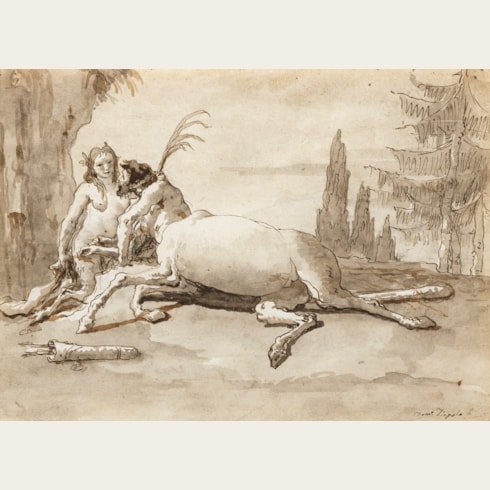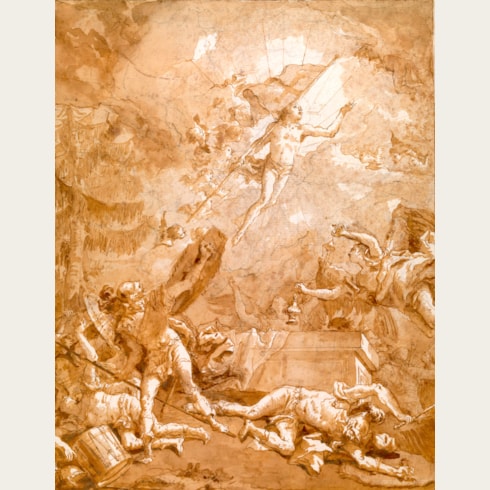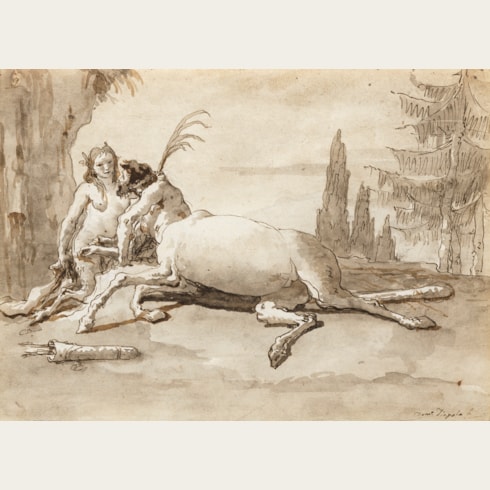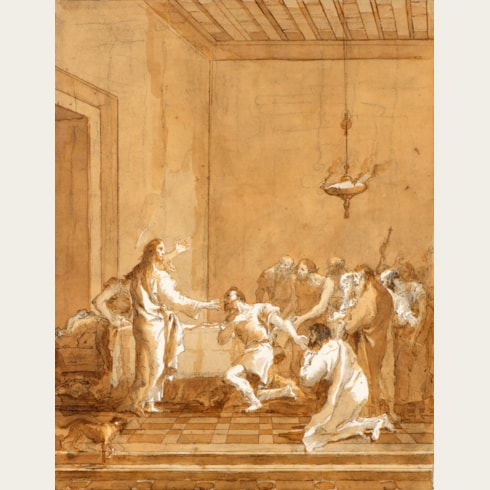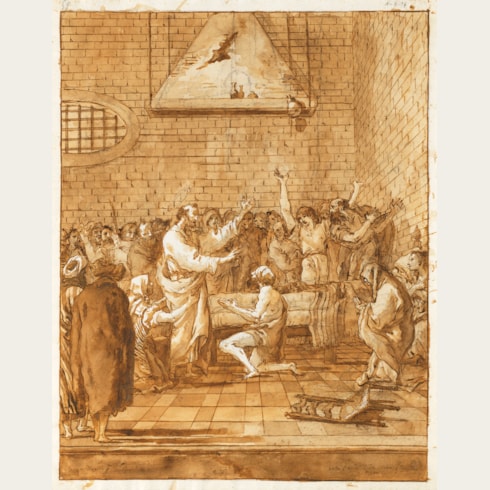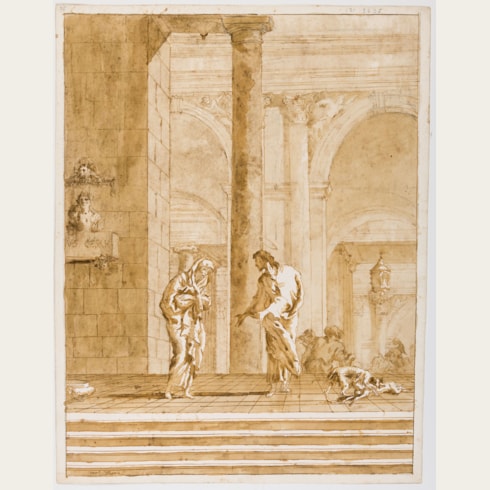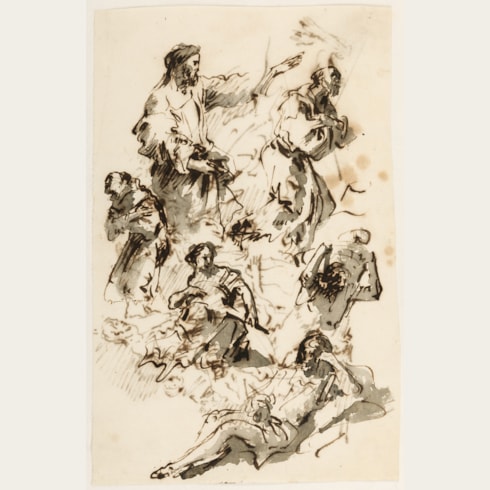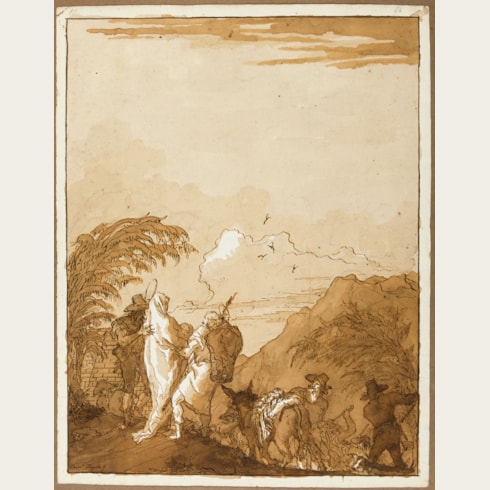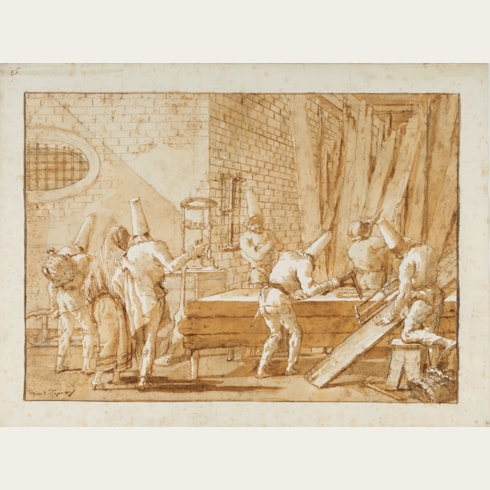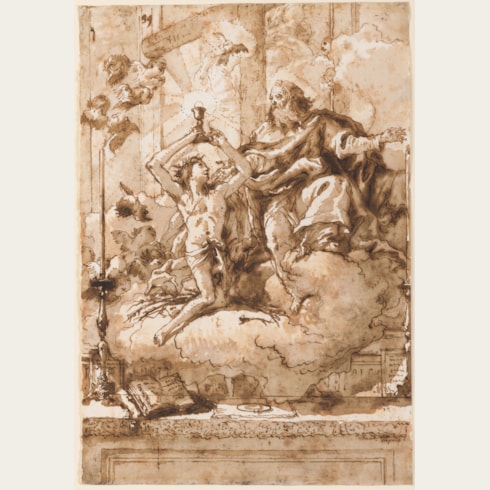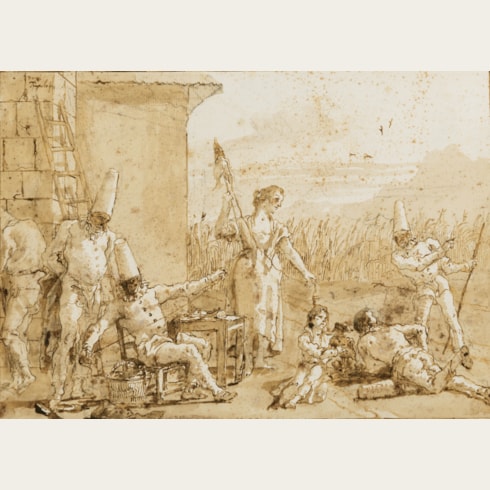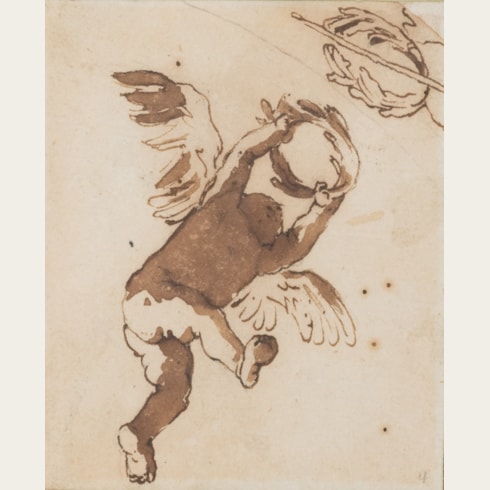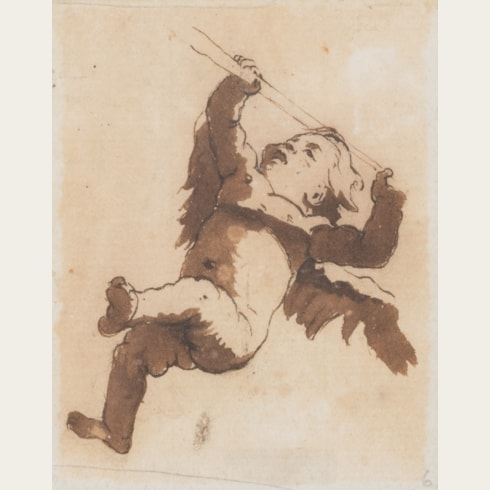Giovanni Domenico TIEPOLO
(Venice 1727 - Venice 1804)
Hercules and Antaeus, with a Lion
Inscribed (with a price code?) EAX in a modern hand on the verso.
210 x 146 mm. (8 1/4 x 5 3/4 in.)
The theme of Hercules and Antaeus must have greatly appealed to Domenico, as he created a large number of drawn variations of the subject. The largest single group of these, numbering thirty-eight drawings and likely to have included the present sheet, were once in a small album formerly in the Henri Bordes collection that was purchased by Colnaghi’s from the Parisian dealer Paul Prouté in 1936. The Bordes album was then broken up and its contents dispersed among public and private collections between 1936 and 1945. Drawings from the group are today in the collections of Harvard University Art Museums in Cambridge, Massachusetts, the Metropolitan Museum of Art in New York, the Ashmolean Museum in Oxford, the Fondazione Giorgio Cini in Venice, and elsewhere.
Apart from the drawings in the Bordes album, a number of other drawings by Domenico of this subject are extant, most of which are numbered, unlike those in the album. Indeed, a handful of drawings from the Hercules and Antaeus series were known before the initial appearance of the Bordes group in 1936. One example, numbered 94, entered the collection of the Kupferstichkabinett in Berlin as early as 1902, while another from the Michel-Lévy collection was sold in Paris in 19194, and a third example appeared on the art market in Amsterdam in 1929. Four other studies of the same subject, also not from the Bordes collection, were included in an album of pen drawings by Domenico Tiepolo that was sold in his lifetime and belonged to Horace Walpole and the Earls Beauchamp before being dispersed at auction in London in 1965.
This group of drawings of Hercules and Antaeus by Domenico Tiepolo does not relate to any painting or fresco by the artist, and may instead be counted among the many pen and wash drawings – all variations on a theme – that the artist produced in the second half of his career. James Byam Shaw has suggested that this particular series of drawings may have been inspired by a drawing or print after a sculptural group of Hercules and Antaeus, such as a small bronze by the Renaissance sculptor Antico, known in several casts. It may also be noted that, early in his career, Domenico’s father Giambattista had painted a large canvas of Hercules and Antaeus for the salone of the Palazzo Sandi in Venice, executed between 1725 and 1726, which is today in a private collection.
Byam Shaw has further opined that the Hercules and Antaeus drawings may have been related to the decoration of the Tiepolo family’s country villa at Zianigo, near Mirano on the Venetian terraferma. Many of the drawings depict the two struggling figures on the same sort of ledge that appears in other drawings by Domenico, mostly of animals, that are likewise thought to have been possibly intended for the fresco decoration of the Zianigo villa. As he notes, ‘It seems possible, therefore, that the subject was at least conceived as a suitable one for the decoration of that villa, and that the series was drawn at a relatively late date in Domenico’s career.’
It may also be relevant, however, that the base on which these figures stand is akin to the pedestals used in contemporary garden statuary. As Linda Wolk-Simon has noted of Domenico Tiepolo’s Hercules and Antaeus drawings, ‘the protagonists are on a base or ledge reminiscent of the pedestals of garden sculptures or of the balustrades of Venetian villas, which were usually adorned with statues of deities, allegorical personifications, and rustic figures...Hercules was a favorite subject for Venetian garden sculpture, occurring frequently in the work of Domenico’s contemporary [Orazio] Marinali and in that of other sculptors of the period...[and] an immediate and relevant model undoubtedly presented itself in these ubiquitous Venetian settecento villa garden sculptures.’
The addition of a lion in this drawing - perhaps meant to represent the Nemean Lion killed by Hercules as the first of his twelve Labours - also occurs in several other examples from the series of Hercules and Antaeus drawings. These include sheets in the Kupferstichkabinett in Berlin, the Ashmolean Museum in Oxford, the Bibliothèque Municipale in Rouen and the Fondazione Giorgio Cini in Venice, as well as a drawing formerly with Stephen Ongpin Fine Art and today in a private collection in Monaco.
Giovanni Domenico Tiepolo is assumed to have begun his career in the family studio by copying his father’s drawings, although he also created his own drawings as designs for etchings, a practice which occupied much of his time in the 1740s and 1750s. His first independent drawings for paintings are those related to a series of fourteen paintings of the Stations of the Cross for the Venetian church of San Polo, completed when he was just twenty. Between 1750 and 1770, Domenico worked closely with his father as an assistant, notably in Würzburg, at the Villa Valmarana in Vicenza and the Villa Pisani at Strà, and in Madrid. From the late 1740s he also began to be entrusted with his own independent commissions, and the drawings for these display a manner somewhat different from that of his father, with a particular interest in lighthearted genre motifs.
Soon after Giambattista Tiepolo’s sudden death in Madrid in 1770, Domenico returned to his native Venice, where he enjoyed much success as a decorative painter. He continued to expound the grand manner of history painting established by his father - the ‘Tiepolo style’, as it were – and by 1780 his reputation was such that he was named president of the Accademia di Belle Arti in Venice. Within a few years, however, he seems to have largely abandoned painting. In his sixties and living effectively in retirement at the Tiepolo family villa at Zianigo, on the Venetian mainland, he produced a large number of pen and wash drawings that are a testament to his inexhaustible gift for compositional invention.
For much of the last twenty years of his career, Domenico Tiepolo seems to have painted only occasionally, and instead worked primarily as a draughtsman, producing a large number of pen and wash drawings that may collectively be regarded as perhaps his finest artistic legacy. These drawings were, for the most part, executed as a series of several dozen or more themed drawings, many of which were numbered. Among these are several series of drawings of religious and mythological subjects, as well as a varied group of genre scenes, numbering around a hundred sheets, generally referred to as the so-called ‘Scenes of Contemporary Life’, and a celebrated series of 104 drawings entitled the Divertimenti per li regazzi, illustrating scenes from the life of Punchinello, a popular character from the Commedia dell’Arte.
Domenico’s highly finished late drawings, almost all of which were signed, were undoubtedly intended as fully realized, autonomous works of art. While it is certainly possible that they were produced as works of art to be offered for sale to collectors, almost none of the drawings appear to have been dispersed in Domenico’s lifetime. The fact, too, that many of the drawings are numbered, possibly by the artist himself, and that most remained together in groups for many years after his death, would also suggest that they were retained in his studio throughout his life, as indeed he also kept numerous albums of drawings by his father. It is most likely, therefore, that these late drawings by Domenico were done simply for his own pleasure. Nevertheless, they have consistently enjoyed immense popularity since the artist’s death, and continue to entice collectors today. As Catherine Whistler has noted, ‘Domenico’s spirited and inventive independent sheets have long been appreciated, particularly by French and American collectors of the late nineteenth and early twentieth centuries; his quirky sense of humor, acutely observant eye, and zestful approach to his subjects lend his drawings a peculiarly modern appeal.’
As Michael Levey has also noted of the artist, ‘Domenico Tiepolo’s drawings provide us with the more private side of him, but they also serve to represent his career at all stages. He drew continually: sometimes very closely in the manner of his father; at the opposite remove, in the late Punchinello drawings for example, his manner and matter could never be mistaken for anyone else’s...The key to Domenico is in drawings: he began as a draughtsman and, one is tempted to say, all his paintings betray the draughtsman.’
Provenance
Probably Galerie Paul Prouté, Paris, until 1936
Probably P. & D. Colnaghi, London, by 1936
Private collection.

